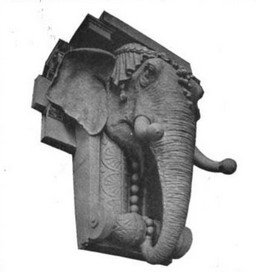To “see the elephant” is U.S. slang that means to see amazing sights or to gain knowledge beyond the everyday. The phrase originated in the early nineteenth century, after the first elephants toured the Eastern seaboard: the earliest visitor was simply called “The Elephant” in the press; the second was named “Old Bet,” short for Elizabeth. Encounters with these remarkable animals took on a metaphorical cast and often described grueling experience: overland travelers who were part of the California Gold Rush and soldiers who had engaged in battle in the Civil War commonly said they “saw the elephant.”
Patent for Zoomorphic Architecture received by James V. Lafferty, via Wikpedia
By the turn of the twentieth century, the phrase is roughly equivalent to enjoying the night life of a city: an O. Henry narrator says in a story titled “Man about Town” that the titular urban fellow “makes his rounds every evening, while you and I see the elephant once a week. This incarnation referred not to Old Bet or Jumbo but to the Elephantine Colossus on Coney Island.That structure, covered in tin skin studded with windows, housed an amusement bazaar, a hotel, and later a brothel. The building burned in 1896; Thompson and Dundy’s famed attraction “A Trip to the Moon” was built on its former site. It was a foundational ride for Luna Park, where the story of the Hippodrome elephants begins.
An illustration of Topsy, a female Asian elephant killed at a Coney Island, New York park by electrocution on January 4, 1903. Via Wikipedia
Along with the land that had formerly been Sea Lion Park, Thompson and Dundy purchased an Asian elephant named Topsy. Topsy had a violent history: she may have killed two elephant keepers in 1900, and she crushed one man who tormented her — throwing sand in her face and stabbing her trunk with a lit cigar — and threatened to do so to another. Topsy’s story is a tragic one, dealt with in tremendous detail in Michael Daly’s book. The relevant piece of information for this story: Topsy was electrocuted on camera for an Edison film called “Electrocuting an Elephant” (not linking to it, but easily findable) that doubled as an advertisement for Thompson and Dundy’s Luna Park opening that summer. It’s not a graphic film, but it is sad and shocking. One of the things I’m trying to work out in the chapter I’m writing is how T&D got into the elephant game at a transitional moment, moving from the panic about “bad elephants” around the turn of the twentieth century to the kind of infantilized and ridiculous elephants of the mid-twentieth century (think elephant ballerinas in Fantasia).
Fred Thompson was obsessed with elephant imagery. He kept a carved ebony elephant sculpture on his desk at Luna Park, and when Topsy was killed he reportedly had her hide tanned and used it to cover his office chair. So it’s not surprising to learn that elephants were built into the very architecture of the New York Hippodrome. An elephant’s-head keystone decorated the central arch of the main entrance. That head was larger than life size, sculpted from terracotta, and weighed two and a half tons.
Grandeur and gaudiness combined in this ornamentation, and architectural critics held mixed opinions on the effect. One journal found it original, appropriate to the site, and highly praiseworthy. Another praised the keystone as simple and aesthetically pleasing but criticized the interior heads. They all agreed that this vernacular embellishment came from the world of world’s fairs, circuses, and amusement parks.
“The New York Hippodrome. J.H. Morgan, Architect.” Architects’ and Builders’ Magazine, W.T. Comstock, 1905, pp. 490–99. Page 494.
Elephant’s head capitals topped supporting columns in the auditorium and decorative pilasters in the lobby. In photographs, the lobby ornaments look particularly outsized, with heads the size of ticket booth windows and trunks extended down the front of the columns. Their design mixed realistic elements — wrinkled skin, ears hanging in loose folds — with decorative ones.
Detail from New York Hippodrome Theatre, Internet Broadway Database, Bill Morrison Collection, Shubert Theatre Archive
In the interior hallways, each elephant fixture sprouted three incandescent lights from its headdress and two from the tips of its tusks. One source suggests that their eyes illuminated as well. Elephant heads lit by electricity seem especially evocative of Topsy’s execution. The technological violence required to tame these animals is built into the structure.
Overall, I think elephants are so important as a symbol of the New York Hippodrome because they’re architectural. They are massive, grander than human scale. And for Thompson and Dundy, they were easily abstracted into a symbol of circus power, tamed and stylized, covering every part of their new venue.




